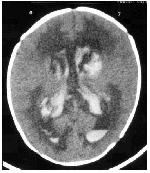A male infant aged seven weeks was referred to Department of Pediatrics, Selçuk University, Meram Medical Faculty because of coma, fever, convulsions and ICH, detected by cranial computed tomography (CT), from State Hospital. A parenteral antibiotic (sulbactam-ampicilline) treatment had been begun four days ago because of a respiratory tract infection. His sucking had impaired gradually. In the last day, he had suffered convulsion. In the history, his delivery was uneventful and his development was normal. He was breastfed, born at term of healthy mother, in hospital. Intramuscular 1 mg vitamin K had been administered at birth. The family history was negative for any bleeding disorder. At the admission, he was in coma. Physical examination was revealed anterior fontanel bulging, weak pupil reaction, anisocoria, increased muscle tonus, decreased deep tendon reflexes, absence of neonatal reflexes. There were no ecchymoses and petechiae.
Laboratory investigations revealed coagulopathy as follows: protrombin time (PT) was >70 s (normal range: 11-13.5 s), partial thromboplastin time (PTT) >120 s (normal range: 28-36 s), fibrinogen 168 mg/dl (normal range: 125-300 mg/dl), hemoglobin 7.2 g/dL, platelets 230,000´109/L, leukocytes 8380´109/L, SGOT 36 IU/L, SGPT 18 IU/L, total bilirubin 0.5 mg/dl, direct bilirubin 0.2 mg/dl, urea 10 mg/dL, sodium 138 mmol/L, potassium 5.2 mmol/L, calcium 10.3 mg/dL, glucose 187 mg/dL. Microscopic examinations of urine and stool were normal. Lumbar puncture did not indicate meningitis but revealed hemorrhagic fluid. Cultures of blood, urine, stool and cerebrospinal fluid were normal. One day after the vitamin K administration (2 mg intravenously), PT was 12.7 s and PTT 30.6 s. Cranial CT showed intraventricular hemorrhage (Figure 1).
Ventricular tap, mannitol, phenobarbital, and packed red blood cells were administered. Nevertheless, hydrocephaly was developed. The patient was referred to neurosurgery department because of ventriculoperitoneal shunt surgery. At the follow-up, the patient was experienced epilepsy, developmental delay and blindness.



